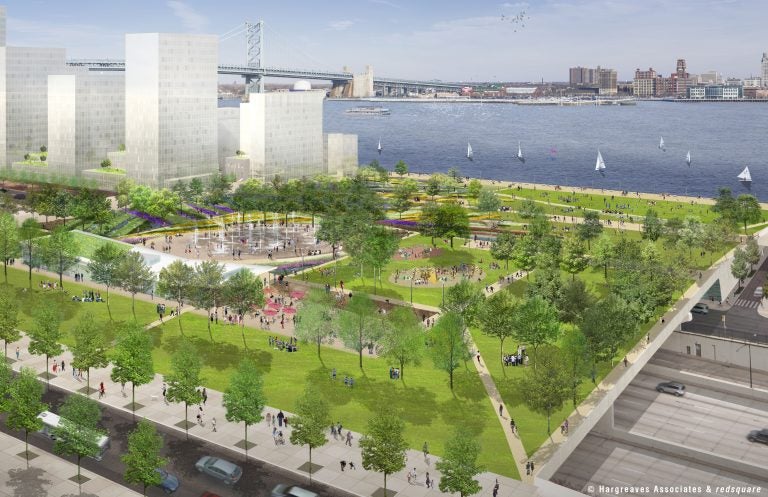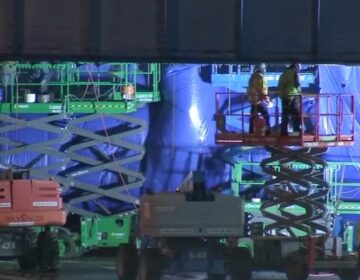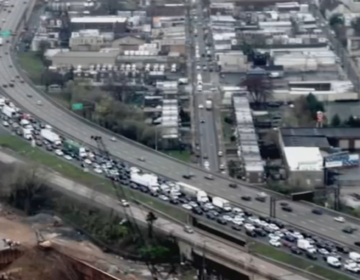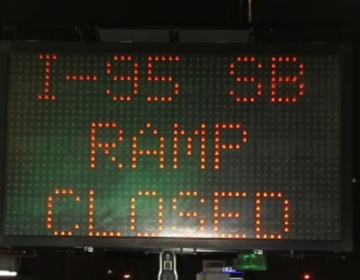From trucks to trails, Philly’s new $181 million bond will pay for improvements citywide
A new dock for dragon boats, HVAC systems for the city’s homeless shelters, and a cap for I-95 along Penn’s Landing are among the capital projects.

Plans for a new waterfront park over I-95 at Penn's Landing (Courtesy of Hargreaves Associates & redsquare)
This article originally appeared on PlanPhilly.
—
A new dock for dragon boats, HVAC systems for the city’s homeless shelters, and a cap for I-95 along Penn’s Landing are among the capital projects Mayor Jim Kenney will fund with the $181 million municipal bond Philadelphia voters approved on Tuesday.
The bond dollars constitute a relatively small slice of the $4.7 billion capital budget for next year. But the bond proceeds will help the city leverage private, state and federal money sources, which often require local matching funds — combined, those outside sources make up 35 percent of the city’s FY 2019 capital budget.
The credit line increase comes at a time when the city is working to realize a number of ambitious public works projects. Many of them will share in the $174 million that the city will ultimately put in the bank, after paying fees tied to the bond’s issuance.
Here’s what Philadelphia voters bought on Tuesday
The Philadelphia Museum of Art officially broke ground on its Frank Gehry-designed, $196 million overhaul last year. The museum is city-owned, and so the city is chipping in a little: $5 million of the bond proceeds will go toward some of the infrastructure upgrades needed to make way for the ambitious reimagining of one of the city’s most iconic buildings.
On the other side of the Schuylkill River, another beloved cultural institution, the Philadelphia Zoo, will get $1.5 million for renovations to some of the city-owned buildings there.
The Commerce Department will oversee $1.5 million earmarked for improvements to commercial corridors throughout the city. The money will go toward upgrading sidewalks, lighting, landscaping and parking, in an effort to support existing local storefront businesses and inspire new ones to open.
The Philadelphia Industrial Development Corporation will get $3 million from the bond to boost its revolving fund for acquiring and investing in industrially zoned sites throughout the city, which it then sells off to private companies.
One of the city’s largest long-term capital projects is the plan to cap I-95 along Penn’s Landing with an 8-acre park. Kenney committed $90 million in city funds to the project in 2017, PennDOT pledged $100 million, and the William Penn and Knight Foundations have chipped in the rest of the $225 million cost.
This coming year, $500,000 of the bond will go toward preliminary design and permitting stages of the cap project. Another $7.5 million will be spent on other improvements to Penn’s Landing and the Central Delaware Waterfront. And $500,000 is pegged for the North Delaware River Waterfront.
The city’s other river will also get a splash of the bond monies: $2 million is pledged for the Schuylkill River Trail’s ongoing expansion projects.
The city’s other ambitious capital project, Rebuild, got off to a slow start, as opponents fought a long legal battle over the constitutionality of the sweetened beverage tax funding most of it. With that fight now behind the city, work can begin in earnest. But the start is also a bit modest: $1 million of the bond is pegged for the Free Library’s Rebuild budget, and another $7 million will go toward Department of Parks and Recreation-led projects.
Parks and Recreation will see other projects funded by the bond, too, with $1 million going toward an ongoing project to maintain and rebuild the retaining wall along the Schuylkill River. The Horticultural Center will get $200,000 for building upgrades. Design work on improving the East Park Canoe House will get a $400,000 infusion, and another $250,000 will go toward a new dock for dragon boats. The Mann Center is also slated to get $1 million for various improvements.
The Philadelphia Fire Department will get $2 million for ongoing and new upgrades at its stations across the city, including the city’s oldest, the 1891-built Engine 37 in Chestnut Hill.
The city also plans to spend $19.1 million of the bond on some new vehicles. The Fire Department will get the bulk, $10 million, and the Streets Department will get $7.6 million, leaving $1.5 million for cars and trucks used by other city departments.
The city’s homeless shelters will spend $1.2 million from the bond proceeds to replace heating and cooling systems.
A large chunk of the bond will be spent on updating the city’s old technology and computer systems: $15.2 million for hardware, and $6.7 million for software, including upgrades to the city’s accounting systems and the Streets Department’s right-of-way management system. That system tracks and coordinates the dozens of street closures for construction, parties, parades and other events that happen every day.
The Police Department will get money to support its move to 400 N. Broad St. The former Inquirer building will also house the 6th and 9th police districts, the medical examiner’s office and the city’s 911 call center. Along with upgrades to the 2nd, 15th and 22nd police districts, the PPD is getting $21.1 million in budget year 2019.
In addition to that, $5 million will go toward “substantial improvement to meet modern operational and safety requirements,” at the PPD’s firearms training facility. A $6.2 million extension of the Baxter Trail running behind it has been mostly closed because of the danger of ricocheting bullets, despite improvements at the time of the trail’s construction to keep shots within the gun range.
The Streets Department will heavily leverage the $1.5 million share of the bond pegged for Vision Zero traffic safety improvements. Streets officials expect it to yield $3 million in additional federal funds and another $3 million from the state.
The city will also allocate $500,000 for its ongoing replacement of city’s streetlights with brighter, but less energy-intensive LEDS.
Streets will also see $4.7 million used to rehabilitate and stabilize bridges. Another $23.5 million is earmarked for street repaving and the installation of curb ramps mandated by the Americans with Disabilities Act.
Philadelphia will also chip in $5 million for SEPTA-led construction projects across the city, which are estimated to total $227 million in the coming fiscal year.
Another $200,000 will go toward expanding Indego.
Looking beyond the new bond, the largest chunk of the city’s capital budget comes from “self-sustaining” sources. For instance, the Philadelphia Water Department reinvests utility bill payments into replacing old pipes, and Philadelphia International Airport uses the fees airlines pay to upgrade terminals and expand runways. So, while the airport is one of the largest line items on the budget — $600 million in capital spending is earmarked for the coming fiscal year — none of the recently approved municipal bond will go toward it.
WHYY is your source for fact-based, in-depth journalism and information. As a nonprofit organization, we rely on financial support from readers like you. Please give today.






